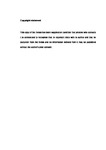The effect of ionising radiation on mussels
| dc.contributor.supervisor | Jha, Awadhesh | |
| dc.contributor.author | Vernon, Emily | |
| dc.contributor.other | School of Biological and Marine Sciences | en_US |
| dc.date.accessioned | 2019-04-05T08:07:59Z | |
| dc.date.issued | 2019 | |
| dc.date.issued | 2019 | |
| dc.identifier | 10407692 | en_US |
| dc.identifier.uri | http://hdl.handle.net/10026.1/13657 | |
| dc.description.abstract |
Ionising radiations have undoubtedly played a vital role in modern society. There is however growing concern of their increasing presence in the environment whether by permitted or accidental release, along with other contaminants. While the effects of ionising radiation (IR) on human and mammalian models are well studied, the impacts on aquatic organisms, which play important roles for ecosystem sustainability are yet to be fully understood. This is particularly for chronic, low dose, environmentally relevant exposures, bearing in mind that many of the discharged radionuclides have long half-lives, to which biota are exposed. In this context a multi-biomarker, multi-species approach was adopted to investigate IR-induced (phosphorus-32, 32P) response, alone and in combination with copper (Cu, an environmentally ubiquitous metal), in two ecologically relevant bivalve species, the marine Mytilus galloprovincialis (MG) and freshwater Dreissena polymorpha (DP) under laboratory conditions. The chosen species play integral roles (ecological, economic and environmental) within coastal and freshwater bodies. Accumulation patterns of Cu (18, 32, 56 µg L-1) and 32P (0.10, 1, and 10 mGy d-1) in isolation varied between the species and tissues. In turn, dose rates (32P) to specific tissues were found to exceed those established for the whole-body for these species. This work demonstrated the importance of determining dose rate at tissue level, and highlighted digestive gland and gill as key tissues of interest for subsequent biological assays. In terms of biomarker responses for DNA damage, given that DNA is an important target for the actions of IR, induction of novel biomarker gamma H2AX (γ-H2AX) was performed alongside more classical techniques, including comet and micronucleus (MN) assays, along with molecular approaches (i.e. transcriptional expression of key genes involved in stress responses) and behavioural level changes. Genotoxicity was well correlated with Cu concentration, and 32P dose rate, both as single and combined stressors. Significant DNA damage was noted at 32 µg L-1 (Cu), and 1 mGy d-1 (32P). In terms of relative sensitivity, overall, MG appeared more sensitive for the induction of γ-H2AX and DNA strand breaks (comet assay), both biomarkers of exposures. In contrast, DP was found to be more susceptible for the induction of MN (biomarker of effects) in the target tissues. The study also highlights that a single screening dose rate may not be adequate to protect all species. The integrated, multi-biomarker, species and tissue approach adopted in the current study provides a thorough, robust methodology which could be further applied to other ecologically relevant species, or reference organisms. The study contributes to the limited amount of information related to understanding of IR-induced biological responses on aquatic biota, alone and in combination with a relevant metallic contamination. It goes some way towards providing the necessary scientific basis for the development of adequate protective policies for both coastal and inland water bodies. | en_US |
| dc.description.sponsorship | Environment Agency | en_US |
| dc.description.sponsorship | Radioactive Waste Management Limited | en_US |
| dc.description.sponsorship | Science and Technology Facilities Council | en_US |
| dc.language.iso | en | |
| dc.publisher | University of Plymouth | |
| dc.subject | Radiation | en_US |
| dc.subject | DNA Damage | en_US |
| dc.subject | Mussels | en_US |
| dc.subject | Ecotoxicology | en_US |
| dc.subject.classification | PhD | en_US |
| dc.title | The effect of ionising radiation on mussels | en_US |
| dc.type | Thesis | |
| plymouth.version | publishable | en_US |
| dc.identifier.doi | http://dx.doi.org/10.24382/1054 | |
| dc.rights.embargodate | 2020-04-05T08:07:59Z | |
| dc.rights.embargoperiod | 12 months | en_US |
| dc.type.qualification | Doctorate | en_US |
| rioxxterms.funder | Natural Environment Research Council | en_US |
| rioxxterms.identifier.project | nerc | en_US |
| rioxxterms.version | NA | |
| plymouth.orcid.id | http://orcid.org/0000-0001-8270-3209 | en_US |
Files in this item
This item appears in the following Collection(s)
-
01 Research Theses Main Collection
Research Theses Main


